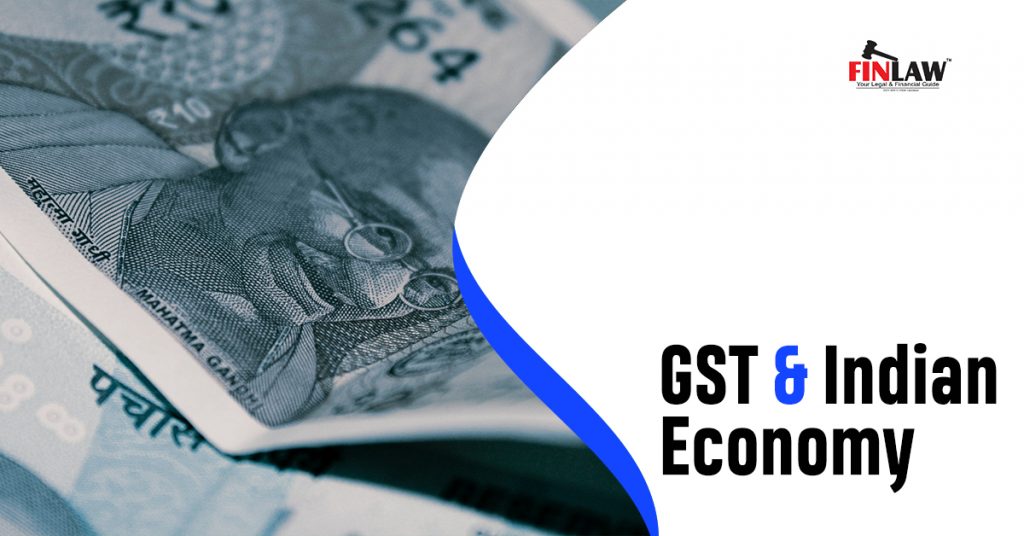
ACCOUNTING & TAXATION
GST & Indian Economy
The growth of Indian economy & growth in collection of GST both are positively correlated to each other.
Goods and Services Tax is defined as the giant indirect tax structure designed to support and enhance the economic growth of a country. GST is consumption-based tax and therefore, it wholly depends on the purchasing power of consumer. Purchasing power of consumer depends on employment and employment depends on economy. So, you may say that GST collections depends on economy or vice-versa.
In present scenario, Country is struggling due to Covid-19. Economy went down, factories are temporary shutdown, some business has been closed and unemployment is increasing day by day. This has caused in lower collection of GST. GST collection is the good source of Government revenue but if there is no consumption then there is no GST collection and it shows excess of expenditure over income from the point of view of Government. Again, Economy will suffer.
Apart from current situation i.e., impact of covid-19, tax regime has become convenient reducing duplication and multiplicity of tax filings creating ease of doing business. From a macro-economic perspective, the government and industry expected that the GST would be instrumental in reducing economic distortions, which in turn, would provide necessary impetus to economic growth. The Ministry of Statistics and Programme Implementation has declared India’s GDP growth to be 7.7% in 2017-18 compared to 7.1% in 2016-17. After the initial phase of GST implementation, marginal improvement was expected given the scale of changes in business and tax administration that it got along.
Benefits of GST & its impact on economy
- Simplified tax system: GST replaces almost all types of indirect tax. This model not only captures the current structure of the entire Indian economy but also proves more realistic dynamic evolutionary paths of the economy over many years to come. Due to simplifications, it helps to small businessmen also. People will able to focus on business instead of tax.
- Reduction in prices of goods and services due to elimination of cascading: This will help to individual & increase their purchasing power. If purchasing power increase, demand will increase & therefore, economy will go up.
- Transparency in taxation system: GST eliminates offline activities or paper work. All most activities of GST perform online & therefore, it will show transparency in collections and increase revenue for Government.
- Increase in employment opportunities: GST creates employment opportunity in India. Increase in employment will increase consumptions & increase in consumption helps in build economy.
Conclusion
Impacts of GST so far seems good opportunities for the development of the economy. Some facts and forecast regarding GST:
- Impacts of GST reforms are very positive for growth, capital formation, investment, consumption and employment in the Indian economy.
- Higher growth rate allows more consumption which is higher than 6.3 percent relative to the benchmark.
- In general, the GST thus raises capital intensity of the Indian economy. Impact on employment is positive but GST reforms raises employment only up to 1 percent above the benchmark. This is partly due to substitution of labour by capital. Creating more employment requires expansion of labour-intensive service sectors along with investment in human capital.
- The distribution of income also becomes more equal after the GST reforms. The economic wellbeing of households and their consumption increases up to by 8 percent above the benchmark. They also increase labour supply to take up jobs created additionally.
- In general, by liberalizing the economy, the GST reforms make a very positive atmosphere for investment and capital accumulation. Capital stock expands up to 60 percent above the benchmark economy because of expansion in investment and more efficiency in the use of capital that reduces the cost of capital. Rapid expansion in production creates this supply side response, GST reform plays a vital role in this direction.
- By eliminating the cascading effects of multiplicity of taxes and by removing the red-tape in the tax administration, GST reduces the cost of supply of goods and services. This results in up to 20 percent reduction in prices of commodities relative to benchmark. Consumers are better off as they get commodities at lower prices, producers also gain as the cost of capital decrease. Economy becomes more competitive in the international market. Thus, GST reforms is one step to realize the dream of “make in India” initiative of the Modi government. It will not only stabilize prices and raise the standard of living in India but also will make India more competitive in the global market.
- Economy creates more employment in the service sectors including the transport and storage, hotel and restaurant, food and beverages and textiles, health and education and community services sectors after the GST reforms. Some additional measure needs to be taken to prevent loss of employment in construction, non-metallic mineral products or fabricated metal products. As stated above increase in capital intensity is the reason for job losses in these sectors. Investment in human capital can correct this.
